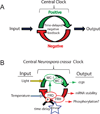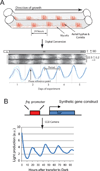The circadian clock of Neurospora crassa
- PMID: 21707668
- PMCID: PMC3203324
- DOI: 10.1111/j.1574-6976.2011.00288.x
The circadian clock of Neurospora crassa
Abstract
Circadian clocks organize our inner physiology with respect to the external world, providing life with the ability to anticipate and thereby better prepare for major fluctuations in its environment. Circadian systems are widely represented in nearly all major branches of life, except archaebacteria, and within the eukaryotes, the filamentous fungus Neurospora crassa has served for nearly half a century as a durable model organism for uncovering the basic circadian physiology and molecular biology. Studies using Neurospora have clarified our fundamental understanding of the clock as nested positive and negative feedback loops regulated through transcriptional and post-transcriptional processes. These feedback loops are centered on a limited number of proteins that form molecular complexes, and their regulation provides a physical explanation for nearly all clock properties. This review will introduce the basics of circadian rhythms, the model filamentous fungus N. crassa, and provide an overview of the molecular components and regulation of the circadian clock.
© 2011 Federation of European Microbiological Societies. Published by Blackwell Publishing Ltd. All rights reserved.
Figures




References
-
- Allada R, White NE, So WV, Hall JC, Rosbash M. A mutant Drosophila homolog of mammalian Clock disrupts circadian rhythms and transcription of period and timeless. Cell. 1998;93:791–804. - PubMed
-
- Aronson BD, Johnson KA, Loros JJ, Dunlap JC. Negative feedback defining a circadian clock: autoregulation of the clock gene frequency. Science. 1994;263:1578–1584. - PubMed
-
- Bae K, Jin X, Maywood ES, Hastings MH, Reppert SM, Weaver DR. Differential functions of mPer1, mPer2, and mPer3 in the SCN circadian clock. Neuron. 2001;30:525–536. - PubMed
-
- Ballario P, Talora C, Galli D, Linden H, Macino G. Roles in dimerization and blue light photoresponse of the PAS and LOV domains of Neurospora crassa white collar proteins. Mol Microbiol. 1998;29:719–729. - PubMed

